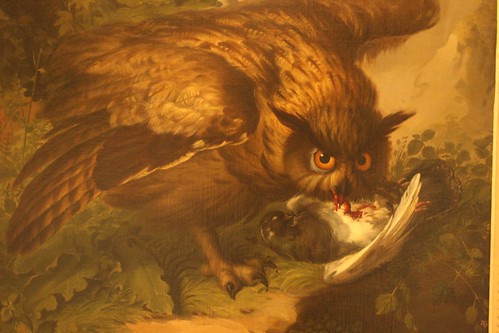Vatican Museum : I haven't done all that many travel updates here, The people say the Vatican City is very small, but there seems to be no limit to the number of tourist buses that can fit inside.

The Museum is relatively well set up for the crowds, but as you'd expect for any old building there are some kinks. Still, there turned out to be ample places inside where I could escape the press of flesh.
One of the first things you notice upon entering the Vatican Museum is that everybody is there to see the Sistine Chapel, and very few people really want to see anything else. As you enter the giant courtyard, you see that it is lined with ranks of identical information stations, all of them about the Sistine Chapel:

You can see that most of these stations have a tour group clustered around. The tour guides can't really do their spiel in the Chapel itself-- even though most of them are using wireless comm systems with their groups -- because it's way too crowded. So each guide sets up her group at a station and goes through an introduction to the Chapel, before marching the group down the kilometer of hallways to actually get to the place itself.
It's surreal. There are literally a dozen of these stations waiting for groups to do this. If you're looking for the Sistine Chapel, you've got to be figuring this is an ominous sign.
Not nearly as ominous as this: the other occupant of the courtyard is none other than the Eye of Sauron.
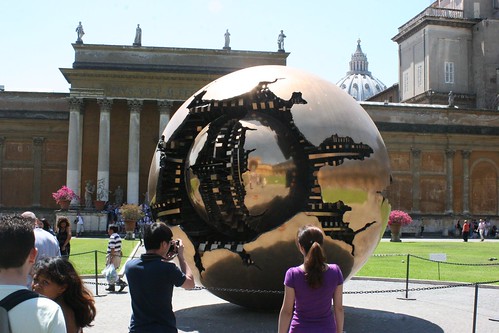
I have no idea what that is really supposed to be. Very few things in the Museum are labeled. I'm sticking with the hypothesis that Benedict XVI actually became the caretaker of the Eye after the fall of Barad-Dur. I confirmed this as I saw four hobbits having their pictures taken in front of it:
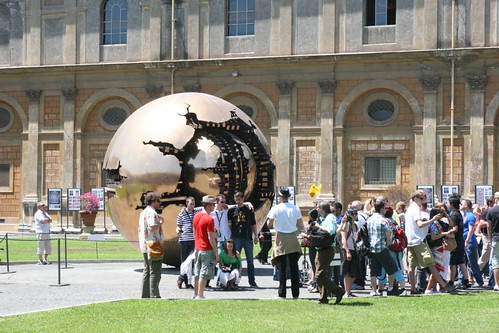
However, the thing rotates around, and a look at the other side presents a different hypothesis.
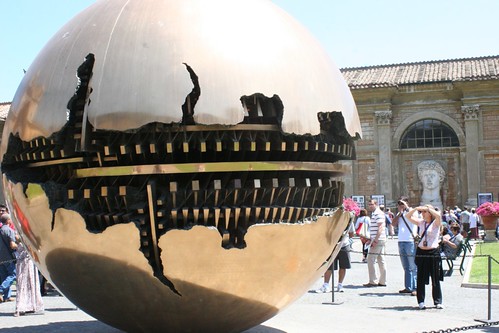
Behold the power of this fully armed and operational battle station!
Ah, yes, fun times.
After not very long, I began to realize that the Vatican Museum is basically the papal version of The House on the Rock. This is the tourist location in southern Wisconsin started by a man who first built an interesting house, and then went wild with collections and folk art. He built warehouses, one giant whale, and a Scaramanga-like old town, complete with giant creepy music devices. Unlike the Vatican, it was featured in Neil Gaiman's book, American Gods.
Quirky as it is, the House on the Rock had the influence of a single designer. The Vatican Museum did not, and it shows. Some parts of the complex seem like afterthoughts, others are just stack after stack of old stuff.
Here's a hall mostly full of old heads, and another camera in the act of flashing:
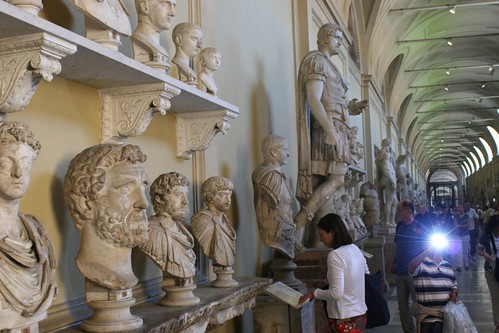
Some of the popes really had a taste for old Roman statuary, so they collected them. That was a real service, considering that many of them were dug up during the course of building medieval and later Rome, and they might otherwise have been destroyed or lost. On the other hand, some of the stuff here was collected by going around to old monuments and defacing them. For instance, there's a whole hallway, closed to the public, full of inscriptions taken from tombs and buildings. A Vatican bigwig in the sixteenth century arranged them on the wall by subject. I wonder what they would tell us in their original context.
Here's something you don't see every day, a goddess with two dozen breasts:

I prefer to think of her that way. The label said that some classicists think those are bull testicles drooping off her, which I find roughly 8.3 times more disturbing than two dozen breasts.
I really enjoyed the statuary halls, because they were notably uncrowded. This big gallery didn't have more than 20 or 30 people in it. I even got a shot without anybody in the frame:

Doesn't Octavian look lonely? Hey, where did everybody go?
Well, the answer to that is clear -- they all went to the Sistine Chapel. Turns out the Vatican has a special route for tour groups to bypass most of the collections and buzz through a few rooms on their way to the Last Judgment.
Just to let you know, I did see the Sistine Chapel. It was miserable. It's a very big room -- now I understand why they make such a big deal about Michaelangelo being up near that ceiling for so long. But boy was it unpleasant. Eight hundred people were crammed inside, half of them sitting around the small step at the edge of the room, because it was the only place on the tourist route where anybody could sit down! The room was darkened, with security guards repeatedly incanting, "NO PHOTO", "NO PHOTO!"
With this mass of humanity, the whole room smelled like armpits. You know, serious B.O.
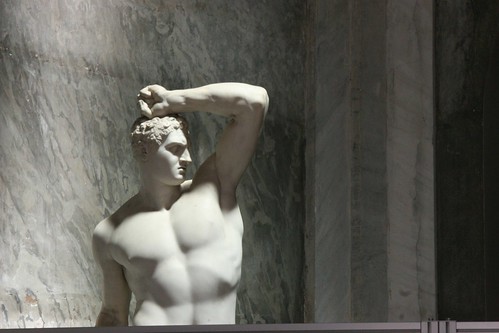
The ironic thing is that a short walk from the Sistine Chapel are several rooms with frescoes by Raphael. Including the famous "School of Athens":

Here's Aeneas working hard to carry his dad out of burning Troy.

Did Troy have Dutch windmills?
The tour groups totally bypassed these rooms on their way to Michaelangelo. Well, I did hear one tour guide explaining how on weekdays the Vatican parking lot is usually full. Four or five people appreciatively nodded, hearing him through their little earbuds.
As you can see, there were no restrictions on photos in the rest of the museum. Just the Sistine Chapel. So I got loads of pictures (not yet uploaded) of stuff, including some lesser-known Raphael works. Here are some saracens about to be separated from their heads:

Not what I thought of first when I hear "Italian Renaissance."
One thing I started to realize is that the popes had really good taste in art between 1500 and 1650, and otherwise not so much. The Vatican Museum has a contemporary art section, really with very little memorable and only two pieces I thought were outstanding (one was a haunting assumption-like piece by Salvador Dali and donated by Juan Carlos of Spain). I don't think there is any shortage of 20th-century art with religious themes, but the collection here was tepid.
Here's one of the more colorful pieces: St. Christopher with a flaming baby Dalai Lama on his back:
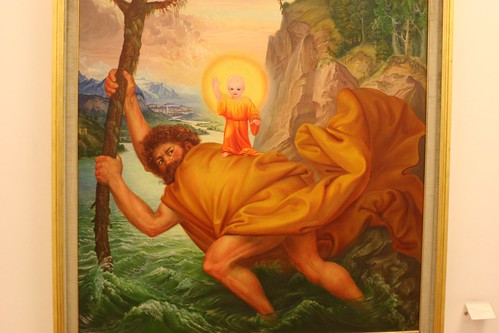
Then there was this. Not quite sure what it was saying:
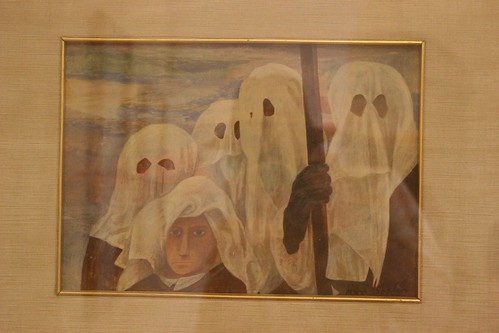
Strangely, the Museum also had Malcolm Forbes' collection of Fabergé on display, including a dozen or so of the famous eggs. It was a traveling exhibit from a private foundation, on loan to the Vatican.
Traffic through the museum goes really only one way, at least during the parts where you're on the Sistine Chapel track. There are two doors out of the Sistine Chapel. One of them goes back to the museum. The other -- the one all the tour groups take -- spits you out into St. Peter's. I found myself intrigued by the cupola, and climbed the seven hundred and some odd steps up to the top. It was quite a view:
If you wonder why I have that look on my face, that tiny white speck next to my right shoulder is a delivery van in the Vatican parking lot. That will give you some idea of how high this really is.
The inner rotunda stop is not nearly so high as the cupola, but it's high enough. Here are some stormtroopers preparing for the arrival of the imperial shuttle:

This was actually an ordination ceremony. I watched for some time, thinking that anybody might come in for such a special event. It turned out to be a cardinal running the show.
After taking the seven hundred and some odd steps back down, I found myself on the floor of the church, where I saw the light:
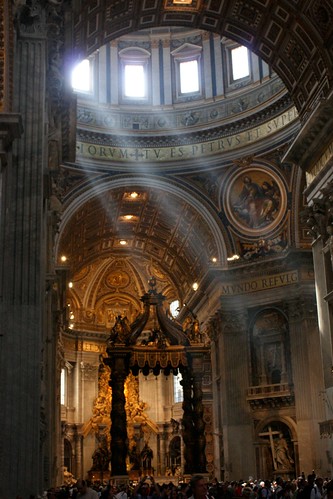
You see, it was at this point I realized that there was no way back into the museum, where I assumed I could continue my tour and collect my backpack from the coat check. It was also here that I realized that the visible employees are all just crowd control, and speak no English. To find this out, I had to make my way past the three hundred people holding their videocameras in the air to capture their special moment fifty yards from the Pietà. What is it with Michaelangelo and tour groups?
Luckily, my broken Italian and my ticket, along with the friendly back door tender, were enough to talk my way back into the Vatican Museum, where I went like a salmon around a dam, up the jumbo exit stairs against the flow of the tour groups. Back into the unpleasantness of the Sistine Chapel ("NO PHOTO, NO PHOTO!") and out the right door. Which turned out to be the left door.
A mere trickle of people were headed back this way, most of them headed straight back the 500 m to the museum entrance. Though the museum was no longer admitting people, two hours of browsing were still left. This notably increased my breathing room, and by 4:30, I often had a room entirely to myself.
I spent most of the time walking around the Old Masters. The collection has a few standouts and many minor works by lesser-known artists before and after the Renaissance.
Here's a cool Garden of Eden I liked:
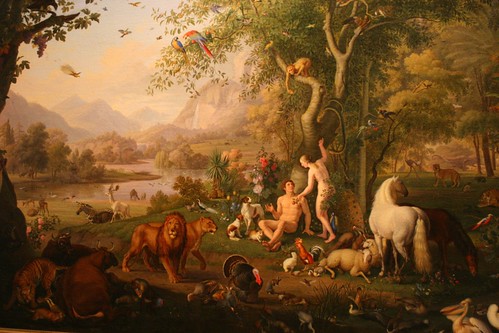
What I love about this one is that the elephant -- stage right in the background behind the leopard and ostrich -- is totally posed like a gomphothere. It's just an elephant, but it had me looking all through the painting for possible extinct animals. At lower left, a badger is standing up to a tiger. Go Bucky!
Well, I have to end the story somewhere, so I'll end with this owl eating a pigeon. It was one of the last paintings I saw in the Museum, before I walked the dusty way up to my apartment.
